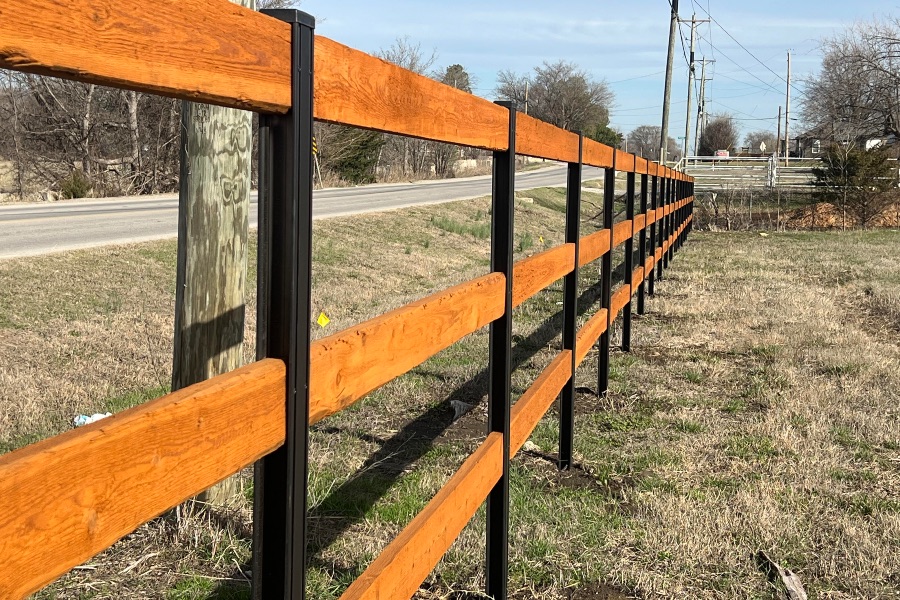All Categories
Featured
When it comes to preserving a wood fence, house owners usually encounter the decision of whether to paint or tarnish. Both options have their cons and pros, and the selection eventually depends upon your aesthetic choices, the kind of wood, and just how much maintenance you agree to commit to. Below's an in-depth comparison to aid you make a notified choice.
The Basics of Painting and Staining
Painting includes covering the timber with a nontransparent layer of color. It supplies total coverage, concealing the timber grain while supplying exceptional protection versus environmental elements.
Staining penetrates the timber, improving its all-natural elegance while adding a safety layer. Depending on the type, discolorations can vary from transparent to strong, allowing differing degrees of wood grain presence.
Pros and Cons of Painting
Pros:
Large Range of Color styles: Repaint deals limitless color options, permitting you to match your fence to your home's exterior or individual style.
Longer Long-term: High-quality exterior paint can last up to 5-7 years, needing less regular reapplication.
Superior Security: Paint forms a thick, strong barrier against wetness, UV rays, and insects.
Disadvantages:
Cracking and peeling: In time, paint can peel off or crack, particularly in areas with extreme climate condition.
Hides Natural Wood Beauty: If you like the natural grain of wood, paint may not be the most effective option.
Greater Maintenance: Repainting requires scraping off the old paint, which can be labor-intensive.
![]()
Pros and Disadvantages of Discoloration
Pros:
Natural Appearance: Stains maintain and boost the all-natural elegance of the timber, making it suitable for high-grade timber like cedar or redwood.
Much Easier to Reapply: Unlike paint, stains do not split or peel off. Reapplying tarnish usually calls for much less surface prep work.
Versatile Complete Options: Discolorations been available in transparent, semi-transparent, and strong varieties, using different degrees of insurance coverage.
Disadvantages:
![]()
Shorter Lifespan: Discolorations, semi-transparent and particularly transparent ones, might need reapplication every 2-3 years.
Minimal Color Choices: While discolorations provide natural tones, they do not have the broad color combination offered with paint.
Much Less Protective: Discolorations permeate the timber but do not give as thick a barrier as paint, making them a little less protective against extreme weather.
Variables to Think About
Aesthetic Preferences: If you desire vivid colors and total insurance coverage, paint is the means to go. For a rustic and natural appearance, choose stain.
Wood Kind: Premium woods with lovely grains gain from staining, while lower-grade woods can be painted for a refined look.
![]()
Climate: In moist or wet climates, paint's thicker obstacle might provide much better defense. In completely dry or moderate environments, spots can be sufficient.
Upkeep Commitment: Paint includes much less regular reapplication but even more initiative throughout touch-ups. Staining needs routine maintenance however is simpler to take care of.
Final Ideas
Both painting and discoloration can efficiently shield and beautify your wood fence. The very best choice depends on your top priorities, whether they lean towards aesthetics, durability, or convenience of upkeep. By recognizing the benefits and drawbacks of each, you can select the coating that aligns with your demands and guarantees your fencing continues to be a standout function of your building for several years to come.
The Basics of Painting and Staining
Painting includes covering the timber with a nontransparent layer of color. It supplies total coverage, concealing the timber grain while supplying exceptional protection versus environmental elements.
Staining penetrates the timber, improving its all-natural elegance while adding a safety layer. Depending on the type, discolorations can vary from transparent to strong, allowing differing degrees of wood grain presence.
Pros and Cons of Painting
Pros:
Large Range of Color styles: Repaint deals limitless color options, permitting you to match your fence to your home's exterior or individual style.
Longer Long-term: High-quality exterior paint can last up to 5-7 years, needing less regular reapplication.
Superior Security: Paint forms a thick, strong barrier against wetness, UV rays, and insects.
Disadvantages:
Cracking and peeling: In time, paint can peel off or crack, particularly in areas with extreme climate condition.
Hides Natural Wood Beauty: If you like the natural grain of wood, paint may not be the most effective option.
Greater Maintenance: Repainting requires scraping off the old paint, which can be labor-intensive.

Pros and Disadvantages of Discoloration
Pros:
Natural Appearance: Stains maintain and boost the all-natural elegance of the timber, making it suitable for high-grade timber like cedar or redwood.
Much Easier to Reapply: Unlike paint, stains do not split or peel off. Reapplying tarnish usually calls for much less surface prep work.
Versatile Complete Options: Discolorations been available in transparent, semi-transparent, and strong varieties, using different degrees of insurance coverage.
Disadvantages:

Shorter Lifespan: Discolorations, semi-transparent and particularly transparent ones, might need reapplication every 2-3 years.
Minimal Color Choices: While discolorations provide natural tones, they do not have the broad color combination offered with paint.
Much Less Protective: Discolorations permeate the timber but do not give as thick a barrier as paint, making them a little less protective against extreme weather.
Variables to Think About
Aesthetic Preferences: If you desire vivid colors and total insurance coverage, paint is the means to go. For a rustic and natural appearance, choose stain.
Wood Kind: Premium woods with lovely grains gain from staining, while lower-grade woods can be painted for a refined look.

Climate: In moist or wet climates, paint's thicker obstacle might provide much better defense. In completely dry or moderate environments, spots can be sufficient.
Upkeep Commitment: Paint includes much less regular reapplication but even more initiative throughout touch-ups. Staining needs routine maintenance however is simpler to take care of.
Final Ideas
Both painting and discoloration can efficiently shield and beautify your wood fence. The very best choice depends on your top priorities, whether they lean towards aesthetics, durability, or convenience of upkeep. By recognizing the benefits and drawbacks of each, you can select the coating that aligns with your demands and guarantees your fencing continues to be a standout function of your building for several years to come.
Latest Posts
Experience the Style of Wood Flooring with Carpet Interiors Floor & Home
Published Apr 19, 25
1 min read
Floor Covering Professionals That Treat You Like Household
Published Apr 19, 25
1 min read
Montclare Auto Repair: The Trusted Choice for Expert Brake & Engine Fixes
Published Apr 19, 25
2 min read
More
Latest Posts
Experience the Style of Wood Flooring with Carpet Interiors Floor & Home
Published Apr 19, 25
1 min read
Floor Covering Professionals That Treat You Like Household
Published Apr 19, 25
1 min read
Montclare Auto Repair: The Trusted Choice for Expert Brake & Engine Fixes
Published Apr 19, 25
2 min read